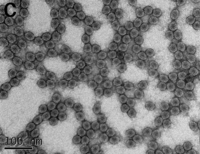
Photo from wikipedia
The leaves of soybean cv. ZheA8901 show various symptoms (necrosis, mosaic and symptomless) when infected with different strains of Soybean mosaic virus (SMV). Based on a proteomic analysis performed with… Click to show full abstract
The leaves of soybean cv. ZheA8901 show various symptoms (necrosis, mosaic and symptomless) when infected with different strains of Soybean mosaic virus (SMV). Based on a proteomic analysis performed with tandem mass tags (TMT), 736 proteins were differentially expressed from soybean samples that showed asymptomatic, mosaic and necrosis symptoms induced by SMV strains SC3, SC7, and SC15, respectively. Among these, GmGSTU13 and APX (ascorbate peroxidase) were only upregulated in mosaic and symptomless leaves, respectively. The protein level of GmGSTU13 determined by Western blot was consistent with TMT analysis, qRT-PCR analysis showed that GmGSTU13 mRNA levels in mosaic plants was 5.26- and 3.75-fold higher than that in necrotic and symptomless plants, respectively. Additionally, the expression of viral coat protein (CP) gene was increased, and serious mosaic symptoms were observed in GmGSTU13-overexpressing plants inoculated with all three SMV strains. These results showed that GmGSTU13 is associated with the development of SMV-induced mosaic symptoms in soybean and that APX is upregulated in symptomless leaves at both the transcriptional and protein levels. In APX gene-silenced soybean plants, the relative expression of the viral CP gene was 1.50, 7.59 and 1.30 times higher than in positive control plants inoculated with the three SMV strains, suggesting that the upregulation of APX may be associated with lack of symptoms in soybean infected with SMV. This work provides a useful dataset for identifying key proteins responsible for symptom development in soybean infected with different SMV strains.
Journal Title: Phytopathology
Year Published: 2021
Link to full text (if available)
Share on Social Media: Sign Up to like & get
recommendations!